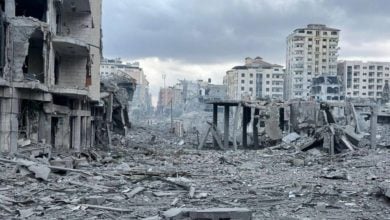Photo: Activists demonstrate against the police killing of Miles Jackson in Columbus, Ohio. Liberation photo
A small demonstration was attacked by police in Columbus, Ohio, on the night of April 13, following a police killing in an emergency room on April 12. The shooting took place at Mount Carmel St. Anne’s Medical Center in Westerville, a suburb of Columbus. The victim, a Black man named Miles Jackson, found unconscious in a vehicle, was receiving medical treatment at the time of the shooting. While medical attention was being sought for him, police say they discovered active warrants for Jackson, and waited by his hospital bedside.
The details of what happened next are unclear. The local police departments, with reputations for misleading the community, have been primarily responsible for relaying information to the public.
The Westerville Chief of Police claimed that Jackson had a concealed firearm, and brandished it upon regaining consciousness. However, the chief was not able to explain how the patient could receive a medical examination and treatment without the weapon being found. Or if officers had been aware of the risks inherent in discharging a firearm around oxygen lines and other potentially flammable medical equipment.
The chief was further unable to clarify if shots were fired by officers from Westerville Police, by officers from Columbus Police, or by the hospital’s armed security.
Local activists made an emergency call to action on the night of April 12, rallying a crowd of about 50 people outside the hospital. Speakers drew attention to how the circumstances of this killing overlap with those of the killing of George Floyd. The trial of Floyd’s killer Derek Chauvin was ongoing at the time of the killing, a trial in which the killer cop’s defense has sought to blame Floyd for his own death with an accusation of drug use. Jackson has been similarly villainized by police and local media.
“We know the state is not going to protect us. We know the police are not here to protect and serve,” said Hana Abdur-Rahim, a Columbus activist who has spent years organizing her community against police brutality and violence.
She continued: “The man who was killed today … was outside of a recovery center, passed out in his car. … If they had not criminalized his addiction he would still be here today, and we see the same thing in the Derek Chauvin trial for the murder of George Floyd. His defense lawyers want to continuously talk about George Floyd’s addiction. It doesn’t matter if he had an addiction. He deserved to live.”
Jackson’s partner, Jazmine Washington, said to local news outlet ABC6: “We were a family. We were trying to grow and be better and violence stopped it. I wanted him to be here with his kids. … He loved his kids and me as his kids’ mother a lot. … He just really was crying out for help.”
The next night, a vigil was held at Mayme Moore park in Columbus, honoring the life of Miles Jackson. Following the vigil, about 50 to 60 attendees moved their demonstration to the Columbus Police headquarters.
Protesters lined up on the sidewalks outside the headquarters, holding signs, demanding answers and accountability. Some attempted to access the headquarters through the front doors to bring the demonstration inside, only to discover that the building had been improperly locked using handcuffs to secure the doors. Protesters pulled on the doors and the handcuffs came loose, predictably as handcuffs are designed to restrain humans and are not engineered to withstand the leverage of swinging doors. Police officers were concealed behind the entryway and rushed forward to assault the crowd, using mace and physical force.
Columbus Mayor Andrew Ginther said in a tweet: “We share the frustrations over police killings of unarmed Black men, and we support nonviolent protests. That does not include breaking into public buildings or violence against officers. Let me be clear: Violence and destruction will not be tolerated.”
From whom will violence and destruction not be tolerated? This is the question on the minds of many Columbus activists and the community members who support them. Officials representing the Columbus Police told local press that protesters maced and bludgeoned police, and that a bolt cutter was used to access the building. But none of these claims are verified by the ample video evidence streamed by protesters on the scene. According to multiple witnesses, the only violence and destruction that happened on the night of April 13 was perpetrated by the armed forces of state power.






